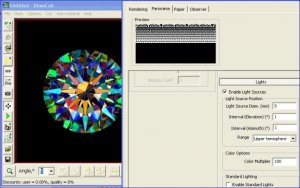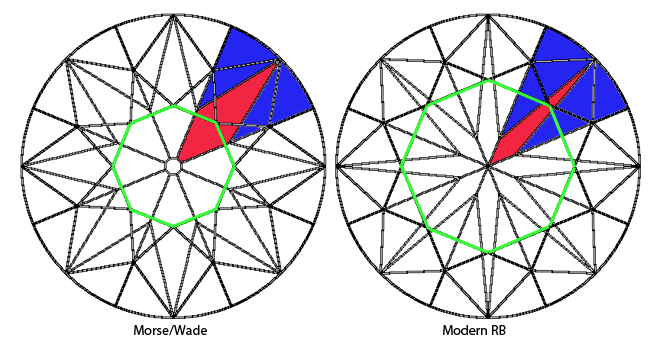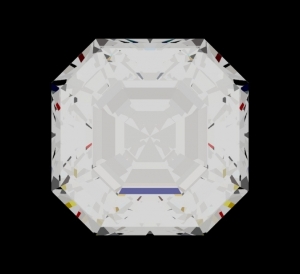- Joined
- Aug 15, 2000
- Messages
- 18,836
Beryl Micheal's article is on his website
Hi Michael,
Clearly there is a trade off in virtual facet size to number of virtual facets. And we know that different people have different preferences.
In addition to your message above - I would add that if you focus on any dark facet - say a pavilion main, as you rotate the stone (or you move) the facet (if it has light return) the will go from dark, through a rainbow color form the blue or the red end of the spectrum, into brighter white, and then back to black via the opposite spectral color. If the lighting is 'fire friendly, then you will move from say red to orange and yellow before white and then from blue through to violet and back to dark.
The change from these facets works best just into Bruces dark zone caused by head obstruction of light sources.
michaelgem|1289623767|2764056 said:
Bruce,
For the sake of discussion fire is the observation of colored light in a diamond due to incident white light. Dispersion is a necessary but not sufficient property of a gemstone for there to be fire. In addition, the virtual facets that emanate fire must be large enough and not overwhelmed by brilliance in order for a diamond to exhibit fire.
Garry often points out that “brilliance is the enemy of fire”.
I like to say that "the same diamond exhibiting superior brilliance in lighting conducive to brilliance will exhibit superior fire in lighting conducive to fire." An example is the pinpoint lighting Garry and Sergey have provided in DiamCalc.
Your comments and insight go to the heart of the matter, because the old mine cut diamonds with their large virtual facets due to chunky, dominant mains, not only results in the "bang-bang" contrast quality of brilliance in usual lighting, but also results in the large flashes of fire characteristic of those cuts when seen in "fire friendly" lighting.
The optically symmetric super ideal that I call the "Central Ideal" has 77% lower half length which is a compromise between large flash brilliance and fire and increased scintillation from more numerous but smaller "virtual facets" as the half length is increased.
In my article, “Accordance in Round Brilliant Diamond Cutting,” I showed the attached photo of an old mine cut compared in the same lighting to a H&A super ideal with 77% lower half length.
In that article I commented: “During the 20th century, the pavilion halves were further increased in length with consequent increase in their area and influence on the diamond’s beauty. The motivation for this increase in the length of the halves was the increased amount of sparkle or scintillation brought about by larger halves. However, a consequence of the increase in the halves in order to favor scintillation was a decrease in the size of the mains. This brought an accompanying reduction of the desirable properties of large flash sparkle and fire that result from larger mains. This large flash fire and sparkle was a fundamental aspect of the appeal of the early round brilliant from Tolkowsky’s era and the prior eras of the Old Mine Cut and the Old European Cut.
Figure 4 contains a photograph of a 2.38ct Old Mine Cut diamond with shorter pavilion halves compared to a four grainer GH EDIT 4 grainer = 1.00ct in human speak, Ideal round brilliant cut with roughly 77% lower halves. Both were photographed in the same “fire friendly”, high contrast, spot illumination, which is lighting favorable to display of fire. Both display the diamond’s ability to break up white light into colors of the spectrum. However, larger flashes of fire, due principally to larger mains, are apparent in the Old Mine Cut compared to the more numerous but smaller flashes of fire in the Ideal Cut.
The cutters of H&A ideals for the Japanese market cut 77% half lengths and I believe many H&A cutters still do. Much cutting today goes too far in my opinion to around 80% or greater. However this is just my opinion, and perhaps the opinion of others who, like you, favor the larger flashes of brilliance and fire from large mains. Maybe cutters on this forum would be willing to comment on this subject.
Michael D Cowing
Hi Michael,
Clearly there is a trade off in virtual facet size to number of virtual facets. And we know that different people have different preferences.
In addition to your message above - I would add that if you focus on any dark facet - say a pavilion main, as you rotate the stone (or you move) the facet (if it has light return) the will go from dark, through a rainbow color form the blue or the red end of the spectrum, into brighter white, and then back to black via the opposite spectral color. If the lighting is 'fire friendly, then you will move from say red to orange and yellow before white and then from blue through to violet and back to dark.
The change from these facets works best just into Bruces dark zone caused by head obstruction of light sources.












300x240.png)